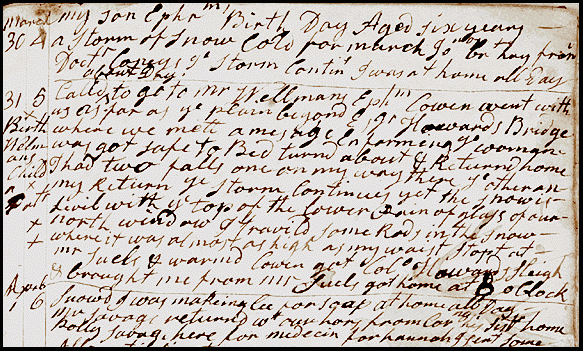|
|
To decode Martha Ballard's diary, you will need to understand how she structured her pages, how she recorded the date, and how she used abbreviations and marginalia. Rollover the headings below to see fragments decoded. Read more about these and other aspects of Martha's diary (her ink, her pen, the layout of the diary, etc.) at the bottom of this page. |
|
|
 |
|
|
||
| Midwifery accounting in her margins -- Martha clearly paid special attention to her midwifery practice. Although she noted numerous other kinds of financial transactions in the body of her diary entries, she kept margin notes only of her midwifery accounts. Most probably this allowed her to find her midwifery accounts quickly when scanning through her diary. Over the years, she labeled and carefully numbered more than 800 deliveries in the left-hand margin of her diary. | ||
|
Martha’s spelling -- Martha spelled words phonetically. And it is apparent that Martha pronounced many words differently than we do. She probably pronounced daughter as "dafter" (much as we pronounce the word laughter as laf-ter) and fatigued as"fatagud" (sounding like fa-tah-gud), since that’s the way she spelled these words. In fact, Martha's spelling provides us with our best evidence of Hallowell, Maine's 18th-century dialect. The dialect expert hired to coach the actors for the film "A Midwife’s Tale" used Martha’s spelling as his most reliable primary evidence. He also used the rhymes in childrens’ books, and the phonetic spelling in other people’s writing. You can hear the actress Kaiulani Lee read one of Martha's entries in Try Transcribing. |
||
|
Martha’s abbreviations -- Some other common abbreviations Martha used in her diary are: yest = yesterday; ys = this; inft = infant; Doct = doctor; Nr = neighbor; aftn = afternoon; foren = before noon; Eveng = evening; Dagt = daughter; ye = the; ys = this; Jona = Jonathan; Colo = Colonel; Capt = Captain. |
||
| Martha's ink -- We know that Martha made her own ink. The diary tells us "the ink this is wrote with was made this day of Cake ink which mr Ballard Sent to Boston for." (9/6/1789) No doubt Martha also made her own pens--from the feathers of her geese. Cutting and slitting the nib of a quill pen took practice, and required a sharp penknife. A practical guide for young people published in Martha's lifetime warned, "Be wise and beware; of blotting take Care." | ||
| The layout of the diary -- Martha Ballard probably ruled her margins with a straight edge before writing. She used her left-hand margins to record the day of the month, the day of the week, and her notes on births. She used her right hand margins to summarize the events of the day (beginning in 1788). And in 1789, she also began writing the month and year at the top of each page. No doubt she adopted these devices to prevent herself from getting lost in the stream of days. | ||
|
Origin of the Format
-- Where did Martha's
diary format come from? Historian Laurel Ulrich's best guess is that
Martha picked up her formatting system from the almanacs widely used
in her lifetime. Two hundred years ago in New England, books were expensive.
But most families owned a Bible and an almanac. |
||
|
Martha's diary might have started as scribbles in an almanac, like this one, on which its owner added personal notes about the events of the day. Almanac booklets, which were published annually, provided calendar dates, information about holidays, astronomical data, and oftentimes advice on planting and harvesting, aphorisms, and short, funny stories. Almanacs helped people keep track of the days, serving a similar function to the modern wall calendars on which we frequently scribble notes about the day's events. |
|
|
|
||||||||||||||||||